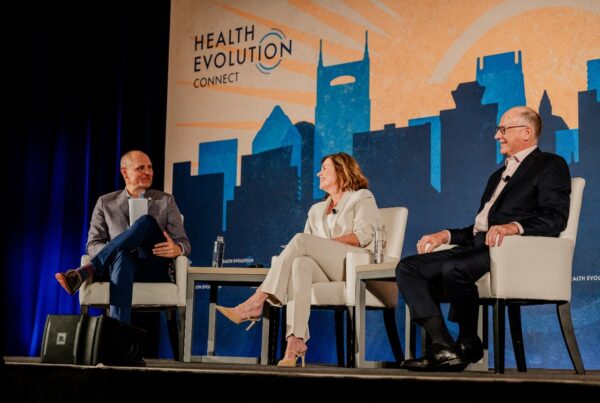How troubled is the U.S. health care workforce, exactly?
Consider: Half of health care workers say they are “defeated by their job,” three quarters indicated they are “tired” and the same percentage are “ready for change”1 while health care jobs were down again in January, bringing the total to some 400,000 fewer than February 2020.2 Looking forward, Mayo Clinic research estimates that one in five physicians and two in five nurses intend to leave their job and one out of every three doctors and nurses plan to reduce their work hours.3
Indeed, workforce has become the paramount challenge for CEOs amid the pandemic — so much so, in fact, that personnel shortages surpassed financial challenges as the top concern for the first time since 2004.4 And that is despite the investor outlook from Moody’s predicting that “operating cash flow will decline by 2-9 percent.”5
While it’s generally understood that frontline health care workers are even more negatively impacted than most people in the COVID-19 pandemic, new statistics illustrate how hard things have become: only one in five frontline health care workers feels appreciated.6
The reality is stark enough that working conditions have been likened to a war zone wherein they “are continuously witnessing the direct effects of the virus as it spreads throughout their community, and they are tasked with taking care of those individuals who have become ill or are dying from the disease.”7
Workforce will be among the topics at the 2022 Health Evolution Summit, April 6-8. Apply to participate.
A January 2022 survey of 175 CEOs, in fact, found that 71 percent said the labor and skills shortage could disrupt their business in 2022.8 That disruption has, in fact, already begun early this year according to data from the U.S. Census Bureau showing that 3 times as many people compared to a month ago and nearly a third more than the same period a year ago are not working,9 either because of COVID-19 or the need to care for someone who is infected.
Against that backdrop, Health Evolution examined several research reports to help better understand what factors, more specifically than the broad pandemic itself, are posing the most significant challenges and what frontline workers and their managers need from the executive team to help address the problem.
Top challenges and why workers are leaving
Specific to health care, 93 percent of workers are experiencing stress. What’s more, 86 percent reported having anxiety, 77 percent are facing frustration, 76 percent are exhausted and burned out and 75 percent say they feel overwhelmed – and that was less than a year into the pandemic.10
The top 5 challenges are: workload (45 percent), low wages (44 percent), long workdays (41 percent), managing customer needs (35 percent) and COVID-19 protocols (33 percent).11
In addition to those stressors, the top reasons employees want to leave their employer, according to a survey of more than 1,000 workers, are: lacking appreciation (21 percent), having a bad supervisor (18 percent), not having the freedom to express themselves (16 percent), working with bad colleagues (11 percent) and being young (10 percent).12 Other reasons include boring work, no opportunities for professional growth, unfair compensation and inflexible work arrangements.13
“As we embark on year three of the pandemic, 58 percent of frontline workers around the world believe that work stress will either stay the same or worsen in the coming year,” according to Microsoft’s Work Trend Index.14
Creating a culture of caring and safer workplaces
What would improve conditions for health care workforces? Communication, compassionate leadership, pay increases and a safer workplace.
To that end, 63 percent of frontline workers say leadership’s messages don’t reach them and, in turn, 32 percent of frontline workers feel their voice is not being heard by management — so it follows that 51 percent do not feel valued.15 Not feeling valued, as previously noted, is the top reason people want to leave their position within 6 months.
Other ways leadership can help include addressing the 60 percent who wish more was being done to relieve physical exhaustion and 57 percent who would like to see more support for mental health.16 Then there are the 71 percent of health care workers who indicated that the pandemic has undermined their sense of workplace safety,17 a particularly important issue given that violence against clinicians has risen in the past few months.18
See also: How record breaking numbers of people leaving their jobs impacts health care
The bottom line, of course, also matters as 40 percent of workers said a pay raise helped to keep them happy at work.19 Another idea presented in the New Year is for hospitals to offer hazard pay as a “a concrete and much-needed demonstration of appreciation to the doctors, nurses, respiratory technicians and other workers who continue to put their lives — and the health of their families — on the line for the public good.”20
While pay increases and hazard offerings won’t end the Great Resignation, financial tactics could help alleviate the projected nurse shortages of 221,000 by 202921 and physician shortages that could be as high as 124,000 by 2034.22
Strategies for building more robust workforces, however, will naturally require more “currency” than money alone. Among the key learnings in the pandemic, rather, is that “a culture of caring is the new currency on the frontline.”23 That will be critical given that 62 percent of all frontline workers do not believe leadership allocates enough resources to building culture.24
“Reducing burnout and improving a sense of feeling valued may allow health care organizations to better maintain their workforce post-pandemic,” Mayo Clinic researchers wrote.25
Sources & Citations:
1. Morning Consult, With health care workforce feeling ‘defeated’ by pandemic, staffing woes could slow recovery
2. U.S. Bureau of Labor Statistics, Current employment statistics highlights, January 2022
3. Mayo Clinic Proceedings, COVID-related stress and work intentions in a sample of US health care workers
4. American College of Healthcare Executives, Top issues confronting hospitals
5. NBC News, Omicron is creating a ‘crisis red-tier situation’ in health care
6. Stericycle, Key insights to safeguard the environment and the environment of care
7. Providence Treatment, Psychological stress among frontline workers
8. Deloitte and Fortune, CEOs say the Great Resignation is their No. 1 concern
9. U.S. Census Bureau, Week 41 household pulse survey, Dec. 29-2021-Jan. 10, 2022
10. Mental Health America, The mental health of health care workers in COVID-19
11. Microsoft, Work Trend Index
12. PlanBeyond, The Great Resignation research report
13. PlanBeyond, The Great Resignation research report
14. Microsoft, Work Trend Index
15. Microsoft, Work Trend Index
16. Microsoft, Work Trend Index
17. Microsoft, Work Trend Index
18. Morning Consult, With health care workforce feeling ‘defeated’ by pandemic, staffing woes could slow recovery
19. Morning Consult, With health care workforce feeling ‘defeated’ by pandemic, staffing woes could slow recovery
20. The New York Times, Opinion: You know what would help exhausted doctors and nurses? More money
21. American Association of Colleges of Nursing, Nursing shortage
22. American Association of Medical Colleges, AAMC report reinforces mounting physician shortage
23. Microsoft, Work Trend Index
24. Microsoft, Work Trend Index
25. Mayo Clinic Proceedings, COVID-related stress and work intentions in a sample of US health care workers










